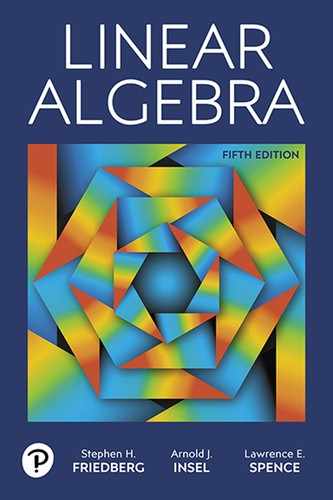Appendix C Fields
The set of real numbers is an example of an algebraic structure called a field. Basically, a field is a set in which four operations (called addition, multiplication, subtraction, and division) can be defined so that, with the exception of division by zero, the sum, product, difference, and quotient of any two elements in the set is an element of the set. More precisely, a field is defined as follows.
Definitions.
A field F is a set on which two operations and (called addition and multiplication, respectively) are defined so that, for each pair of elements x, y in F, there are unique elements in F, denoted and , and such that the following conditions hold for all elements a, b, c in F.
(F 1) and
(commutativity of addition and multiplication)
(F 2) and (associativity of addition and multiplication)
(F 3) There exist distinct elements 0 and 1 in F such that
(existence of identity elements for addition and multiplication)
(F 4) For each element a in F and each nonzero element b in F, there exist elements c and d in F such that
(existence of inverses for addition and multiplication)
(F 5)
(distributivity of multiplication over addition)
The elements and are called the sum and product, respectively, of x and y. The elements 0 (read “zero”) and 1 (read “one”) mentioned in (F 3) are called identity elements for addition and multiplication, respectively, and the elements c and d referred to in (F 4) are called an additive inverse for a and a multiplicative inverse for b, respectively.
Example 1
The set of real numbers R with the usual definitions of addition and multiplication is a field.
Example 2
The set of rational numbers with the usual definitions of addition and multiplication is a field.
Example 3
The set of all real numbers of the form , where a and b are rational numbers, with addition and multiplication as in R is a field.
Example 4
The field consists of two elements 0 and 1 with the operations of addition and multiplication defined by the equations
Example 5
Neither the set of positive integers nor the set of integers with the usual definitions of addition and multiplication is a field, for in either case (F 4) does not hold.
The identity and inverse elements guaranteed by (F 3) and (F 4) are unique; this is a consequence of the following theorem.
Theorem C.1 (Cancellation Laws).
For arbitrary elements a, b, and c in a field, the following statements are true.
If , then .
If and , then .
Proof.
(a) The proof of (a) is left as an exercise.
(b) If , then (F 4) guarantees the existence of an element d in the field such that . Multiply both sides of the equality by d to obtain . Consider the left side of this equality: By (F 2) and (F 3), we have
Similarly, the right side of the equality reduces to c. Thus .
Corollary.
The elements 0 and 1 mentioned in (F 3), and the elements c and d mentioned in (F 4), are unique.
Proof.
Suppose that satisfies for each . Since for each , we have for each . Thus by Theorem C.1.
The proofs of the remaining parts are similar.
Thus each element b in a field has a unique additive inverse and, if , a unique multiplicative inverse. (It is shown in the corollary to Theorem C.2 that 0 has no multiplicative inverse.) The additive inverse and the multiplicative inverse of b are denoted by and , respectively. Note that and .
Subtraction and division can be defined in terms of addition and multiplication by using the additive and multiplicative inverses. Specifically, subtraction of b is defined to be addition of and division by is defined to be multiplication by ; that is,
In particular, the symbol denotes . Division by zero is undefined, but, with this exception, the sum, product, difference, and quotient of any two elements of a field are defined.
Many of the familiar properties of multiplication of real numbers are true in any field, as the next theorem shows.
Theorem C.2.
Let a and b be arbitrary elements of a field. Then each of the following statements is true.
.
.
.
Proof.
(a) Since , (F 5) shows that
Thus by Theorem C.1.
(b) By definition, is the unique element of F with the property . So in order to prove that , it suffices to show that . But is the element of F such that ; so
by (F 5) and (a). Thus . The proof that is similar.
(c) By applying (b) twice, we find that
Corollary.
The additive identity of a field has no multiplicative inverse.
In an arbitrary field F, it may happen that a sum (p summands) equals 0 for some positive integer p. For example, in the field (defined in Example 4), . In this case, the smallest positive integer p for which a sum of p 1’s equals 0 is called the characteristic of F; if no such positive integer exists, then F is said to have characteristic zero. Thus has characteristic two, and R has characteristic zero. Observe that if F is a field of characteristic , then (p summands) equals 0 for all . In a field having nonzero characteristic (especially characteristic two), many unexpected problems arise. For this reason, some of the results about vector spaces stated in this book require that the field over which the vector space is defined be of characteristic zero (or, at least, of some characteristic other than two).
Finally, note that in other sections of this book, the product of two elements a and b in a field is usually denoted ab rather than .
